Adam Yamey's Blog: YAMEY, page 29
December 27, 2024
He took his own drinking water from India to England in 1902
THE MOST DISAPPOINTING tourist ‘attraction’ in Jaipur, is the City Palace. After more than 3 weeks travelling in Rajasthan, I can safely say that this royal palace is the least interesting place we have visited. Architecturally, it lacks the finesse seen in other royal palaces. In addition it is far less interesting historically.
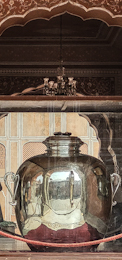
Not wishing to seem too negative about the place, I will mention one item that did catch my attention. It is a huge silver vessel, a jar: possibly the largest silver jar that has ever been made. It and several others were made to carry water from the Ganges to England. The water was for the use of Maharaja Sawai Madho Singh II during his visit to England to attend the coronation of King Edward VII in 1902. Each of the jars could carry about 400 gallons of water.
While this is a fascinating exhibit, I do not believe that the palace is worth visiting. Its admission fees are exorbitant by local standards: minimum of £10 for non-Indians and minimum of £3 for Indians. Additional charges are levied to see certain exhibits within the palace compound. These prices must be compared with the admission fees for the palace’s far more beautiful and much more fascinating neighbour, the Jantar Mantar (non-Indians pay £2, and Indians pay 50 pence).
December 26, 2024
Memorials commemorating the lives of royalty near Jaipur
THE AMBER FORT, which we visited yesterday (17 December 2024), was swarming with noisy, jostling tourists. It was not pleasurable visiting that place. In contrast, today we explored a beautifully peaceful site between Jaipur and Amber Fort: Gatore ki Chhatriya, which I will abbreviate to ‘Gatore’.
Situated between two steep hills, one of which is home to a popular Ganesh temple, the Gatore is a set of three walled enclosures. Each of them contains several ornate domed chhatris (pavilion; ‘chhatri’ means umbrella). Each chhatri was erected over the spot where a member of Jaipur’s royal family (the Kachwaha dynasty) was cremated. After each cremation, the ashes of the deceased were carried to the sacred city of Haridwar, where they were consigned to the waters of the River Ganges.
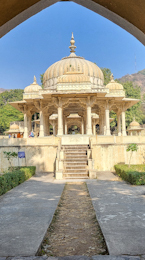
The earliest of the chhatris at Gaitor was put up in 1743, after the cremation of Sawai Jai Singh II. Despite the fact that Indian royalty is no longer officially recognised, the most recent chhatri was constructed in 2011, when the titular ruler, Sawai Padmanabh Singh, died. In addition to the larger chhatris dedicated to the maharajas, there are smaller ones to royal children, who died before adulthood.
Unfortunately, none of the chhatris have any labels that help the visitor know for whom each of these structures was erected. An official at the entrance to the Gaitor compound told us that there had been wooden signs by each chhatri, but locals had apparently stolen them … for use as fire wood, maybe.
Apart from the peacefulness of the Gaitor compound, it is filled with the beautiful chhatris, which are set within well maintained gardens. And the whole place is flanked by the wooded slopes of the hills surrounding it.
If you do not have a long time to explore Jaipur, you should not miss visiting both the Gaitor and the Jantar Mantar. If you have a longer time, the Gaitor is a lovely place to linger.
December 25, 2024
The palace that became submerged by the lake
THE JAL MAHAL (Water Palace) was constructed in about 1699. In the early 18th century, the lake next to it was enlarged, and the palace became partially submerged. Despite many attempts to clear the water from its lower storeys, the palace has remained partially submerged.
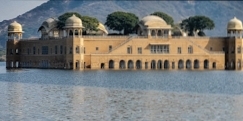
An autorickshaw driver told us that he believed that a djinn (supernatural spirit) resides in the Jal Mahal. Every time an attempt is made to drain the palace, four times as much water as has been removed comes back to flood the edifice.
Recently, an entrepreneur bought the palace, hoping to convert it into a luxury hotel. However, his attempts to dry it out have been a failure, and he has given up.
December 24, 2024
An astronomical extravaganza in the heart of Jaipur
Happy Christmas
IT LOOKS LIKE MODERN sculpture at first sight. On closer examination, these fascinatingly shaped objects have carefully constructed scales, like the markings on a ruler or a protractor, attached to them. They are astronomical instruments that were constructed for the Rajput king Sawai Jai Singh (1688-1743), and they were completed by 1734. Together, they comprise Jaipur’s Jantar Mantar (literally ‘calculating instruments’). They were used to construct what has turned out to be extremely accurate astronomical tables.
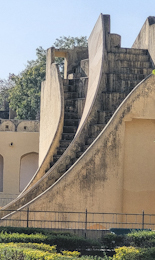
Sawai Jai Singh was very interested in mathematics, astrology, astronomy, architecture, and literature. He studied scientific works by, for example, Ptolemy, Newton, Flamstead, and Euclid. He had Euclid’s “Elements of Geometry” translated into Sanskrit. His interest in astronomy might have been inspired in1702 by his tutor Jagannatha Samrat.
The Jantar Mantar in Jaipur contains 18 separate stone instruments with metal attachments . My knowledge of astronomy is minimal. So, I will not try to explain for what purpose each was, and still can be, used. A Wikipedia page (https://en.m.wikipedia.org/wiki/Jantar_Mantar,_Jaipur) can help with explaining their purposes.
To a visitor, like me, who is unversed in astronomy, and to those who are familiar with modern astronomical instruments, the Jantar Mantar presents the visitor with one of the most extraordinary looking tourist sights that India has to offer. It is not unique. In addition to the one in Jaipur, Sawai Jai Singh built four others in northern India. However, the one at Jaipur is the largest and best preserved.
If one did not know its purpose, the Jantar Mantar observatory compound would seem as if it is one of the world’s most superb sculpture parks.
December 23, 2024
An amazing cinema in the heart of Jaipur
HAPPY CHRISTMAS EVE
THE RAJ MANDIR cinema was completed in 1976. It was designed in the Streamline Moderne ( or late Art Deco) style by WM Namjoshi for Kushalchand Surana. It was conceived by Mehtab Chandra Golcha. According to Wikipedia, it is the largest single screen theatre in Asia.

We went to see a film called “Pushpa part 2”. It was made in the Telugu language and dubbed into Hindi. It is about sandalwood smuggling and corruption. Despite not being able to follow much of the dialogue,it was extremely exciting and beautifully filmed. It was so dramatic that we left the cinema feeing exhausted.
The cinema is spectacular visually. One enters from the street into a huge, circular foyer decorated in an opulent fashion. The auditorium is spacious and, like the foyer, spectacularly decorated. The screen is curved, and the surround sound system very good.
Even if one cannot follow a film because it is in a language that you do not know, a screening at this cinema is an experience not to be missed in Jaipur.
December 22, 2024
One hump and four legs on and off the highway
FOUR LEGS AND ONE HUMP ON AND OFF THE HIGHWAY
WHEN TRAVELLING IN RAJASTHAN it is not unusual to see single-humped camels (dromedaries). Often, they are hitched to wagons, both loaded and unloaded. They can haul loads of several times their body weight, which in adults can range from 400 to over 600 Kilograms. They can also be used to pull ploughs.
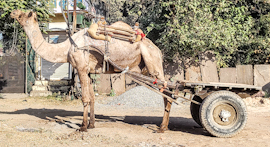
Unlike wheeled vehicles, camels are extremely agile on the roughest of terrains. They are often employed in off-road tasks. And they differ from other beasts of burden by being able to function well in high ambient temperatures. For example, they can survive without drinking for longer than other creatures. Also, their feet are adapted to be able to endure the extremely high temperatures that the ground can reach when it is heated by the sun. I first became aware of this when my PhD supervisor, Robert Harkness, described the research he had done on the connective tissue of the pads within camel’s feet. He had first become interested in this when he spent some time teaching at a university in Kuwait.
During our visit to Rajasthan and also on earlier visits to various parts of Gujarat, we have often spotted camels, both working and grazing. To someone like me, who grew up in Western Europe, seeing camels, which are not in a zoo, is an exciting experience.
Finally, I cannot resist repeating an old joke I learned when I was a child. In those days, there was an airline called British Overseas Airways Corporation, BOAC for short. Some witty friend of my parents told me that BOAC really stood for: “Better On A Camel”.
December 21, 2024
The hands of women about to be consumed by fire
ON THE WALL NEXT to one of the several gates, the Daulat Prole, that leads into the Junagarh Fort in Bikaner, you can see a set of what look like the impressions made by pressing hands into a soft material. Each of these hand prints is labelled in Hindi (Devanagari) lettering. These impressions are amongst the last actions of widows about to commit sati.
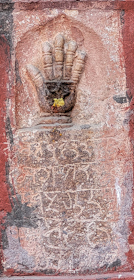
Sati was the usually forced self-immolation of widows. Sati was the tradition in India that involved widows being forced to throw themselves on their husband’s burning funeral pyre. Sometimes, they did it apparently voluntarily. It was a tradition often practised by Rajputs, but not restricted to them. During the British occupation of India, there were various attempts to outlaw sati, but incidences of it continued into the 20th century. Finally, in 1987, the Government of India passed an Act criminalising the practice of sati and its glorification.
Returning to the hands at the Junagarh Fort, one of the officials guides told us the following. Prior to being caste onto her spouse’s funeral pyre, the noble Rajput widow would dress in her finest clothes and jewellery, and approach the Daulat gate. By this time, her hands would have been covered with henna (mehndi). She would then press the palm and digits of her right hand on a stone slab, leaving a print of her hand on it. Later, an artisan carefully carved a three-dimensional impression of the widow’s hand. By that time, the poor woman had been incinerated.
In Rajasthan, various of the Princely States abolished sati in the first half of the 19th century. In Bikaner, the last Maharani to die on her husband’s pyre was in about 1825, so we were told by the guide at the fort.
My eye was immediately attracted to the sati memorials. I wonder how many other visitors to the Junagarh Fort stop and contemplate these tragic memorials before proceeding with taking photographs of each other at the many picturesque spots within the fort.
December 20, 2024
Going Dutch in the fort at Bikaner
UNLIKE JAIPUR, JODHPUR, and Jaisalmer, the city of Bikaner in Rajasthan is not (yet) overrun with tourists. We have been in Bikaner for three days and apart from at the Junagarh Fort (Bikaner’s most significant historical attraction), we have seen only one European visitor. Bikaner differs from the three Rajasthani cities mentioned in the first sentence in that its streets are not lined with shops designed to attract tourists. Apart from the fort the rest of the city is a fascinating, busy working environment, which someone, like me, who enjoys observing everyday scenes of life in India, has plenty to see.
Many of the older buildings that can be seen in the streets of Bikaner have jharokas – decorative, stone-framed windows that project over the street. They are commonly seen features of the Rajput style of architecture and are still being constructed.
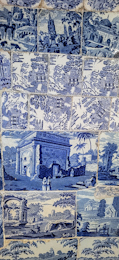
The Junagarh Fort is rich in jharokas. Many of them overlook courtyards within it. One of them is of great interest. From a distance it looked to me like it was decorated with blue and white tiling, like Portuguese azulejo work. Close up, it can be seen to be something else.
A huge consignment of Dutch blue and white Delft ceramic plates had been ordered for the royal family of Bikaner. When that was, I do not know. While they were being transported to India by sea, they were damaged, and arrived broken. Instead of throwing them away, the thrifty maharajah had them cut up to produce tiles, all of which bore details from the pictures that had decorated the plates. The tiles were then used to decorate both the inside and the outside of the jharoka overlooking a courtyard that contains an elaborate water feature: a pool with fountains.
Although there is much more to be seen in the fort, this example of repurposing broken plates intrigued me. The Junagarh Fort is definitely a must-see attraction in Bikaner, but it it is now merely a museum-like remnant of the past. Visitors to the city should see this, but also set aside at least a few hours to absorb the busy atmosphere of enterprise, both traditional and contemporary, in the older districts of Bikaner.
December 19, 2024
Looks like honeycomb and is edible, but it is something different.

GHEVRA IS A Rajasthani food preparation containing ghee, maida (refined flour), milk, and sugar syrup. This mixture is poured into a (usually) circular metal mould and heated vigprously until it attains a texture like honeycomb. Various sweet toppings can be put on the finished Ghevra. We sampled a piece topped with rabri (a sweet made by boiling down milk slowly).
December 18, 2024
A Maharaja at Versailles and his silver soup spoon
THE OLD FORT of Bikaner dominates the centre of the bustling city of Bikaner in Rajasthan. Visitors can view rooms and halls within the fort by joining a guided tour. The tour we joined was led by an intelligent, informative man. The architecture of the fort and much of its interior decorations are spectacular. Amongst the many exhibits we saw were some relating to Maharaja Ganga Singh (1880-1943), who was ruler of Bikaner from 1888 until his death.
The Maharaja’s full title was General Maharaja Sir Ganga Singh, which reflects his role during two world wars. During WW1, he commanded the Bikaner Camel Corps, which served in France, Egypt, and Palestine. Before that, he served in China during the suppression of the Boxer Rebellion. During WW1, he was appointed a member of the Imperial War Cabinet. Because of this, he was present at the signing of the Treaty of Versailles in 1919. He was the only Indian signatory, the only non-European, at this momentous occasion. Later, he represented India at the League of Nations. In addition to his military achievements, Ganga Singh did much to improve the living conditions and economy of his state.
 The Maharaja’s soup spoon
The Maharaja’s soup spoonWithin the fort there are many memorabilia connected with Ganga Singh. The most intriguing of these is a silver spoon designed so that the Maharaja could eat soup without it touching his impressive moustache. The bowl of the spoon has a barrier that would have kept the moustache pushed away from the soup in its bowl.
Among many other souvenirs of Ganga Singh is a De Haviland DH-9E aeroplane. This was one that had been shot down during WW1, and given to Ganga Singh in recognition of Bikaner State’s services during the war. It was restored by Maharaja Karni Singh in about 1985, and is now housed in one of the fort’s huge assembly halls.
I have described two of the things that amazed me during my visit to the fort. I plan to describe more soon.



